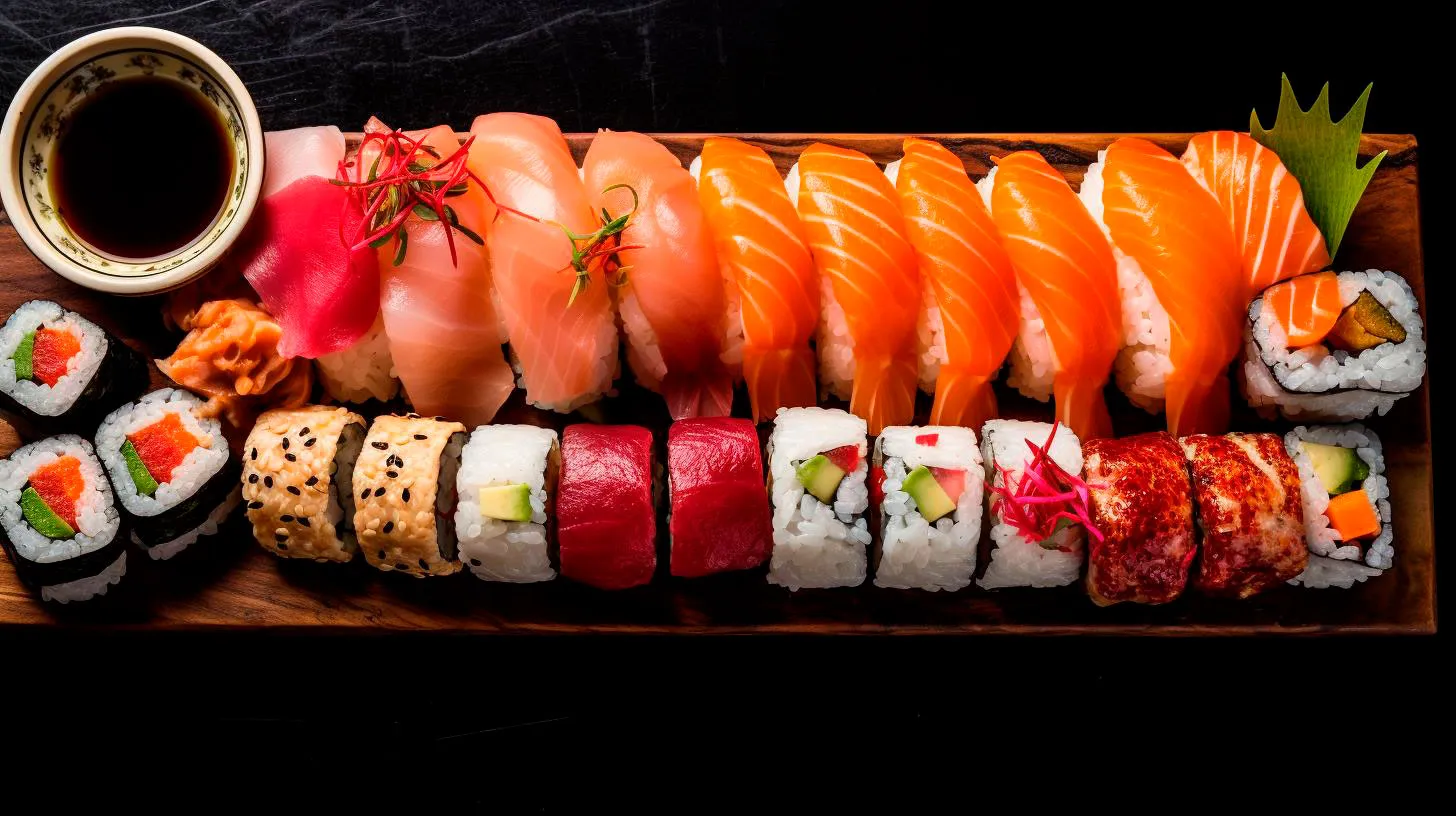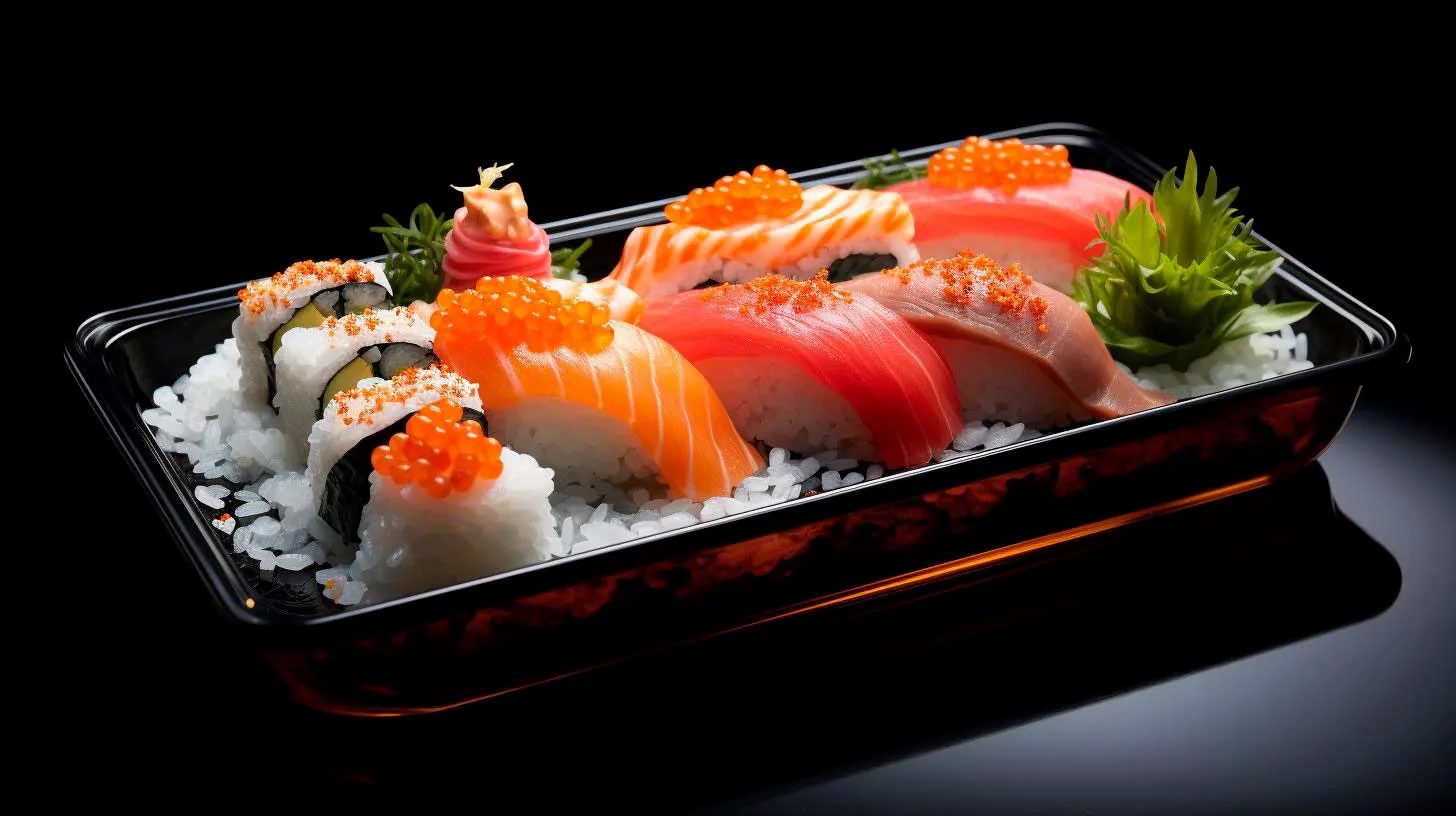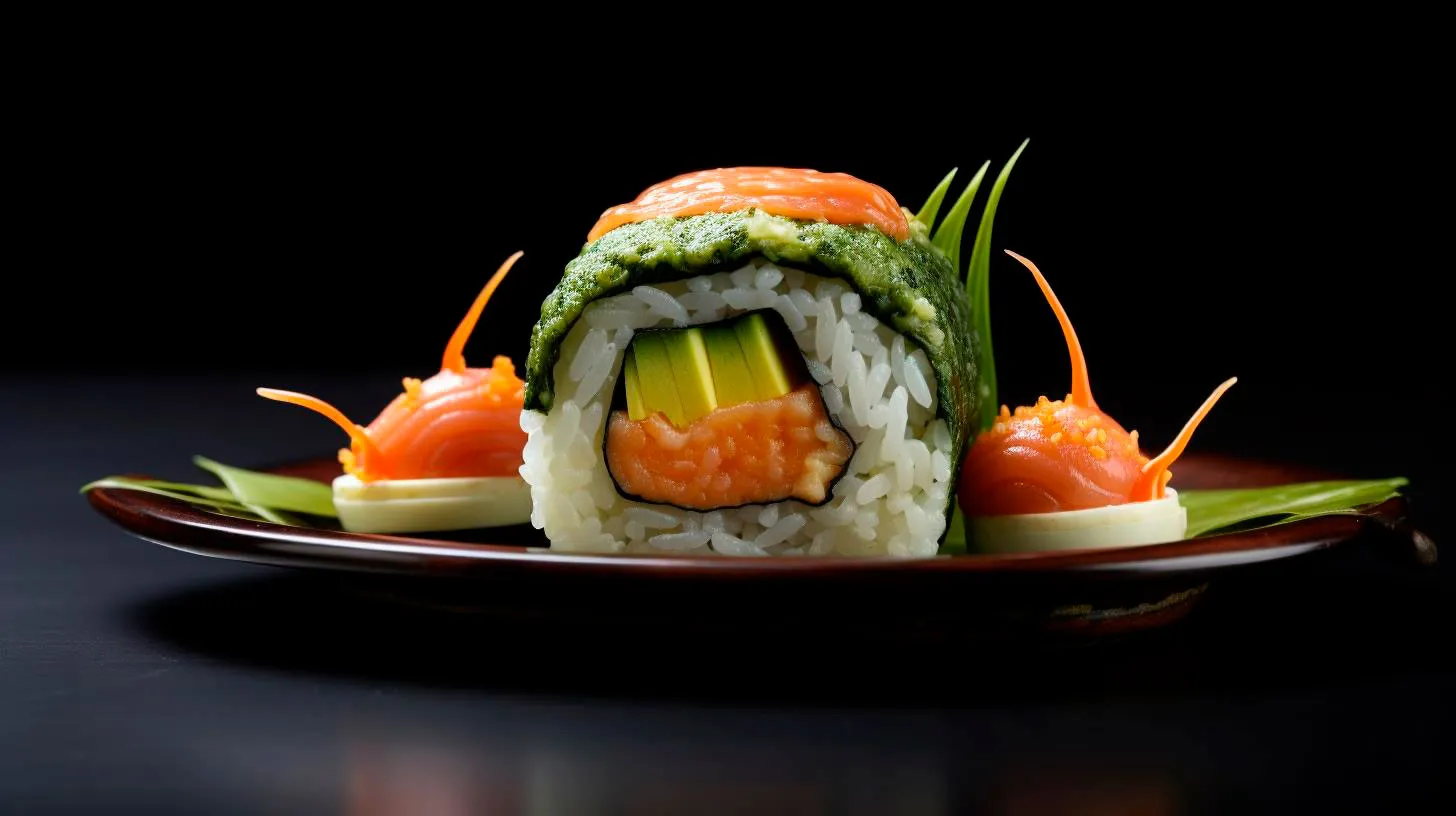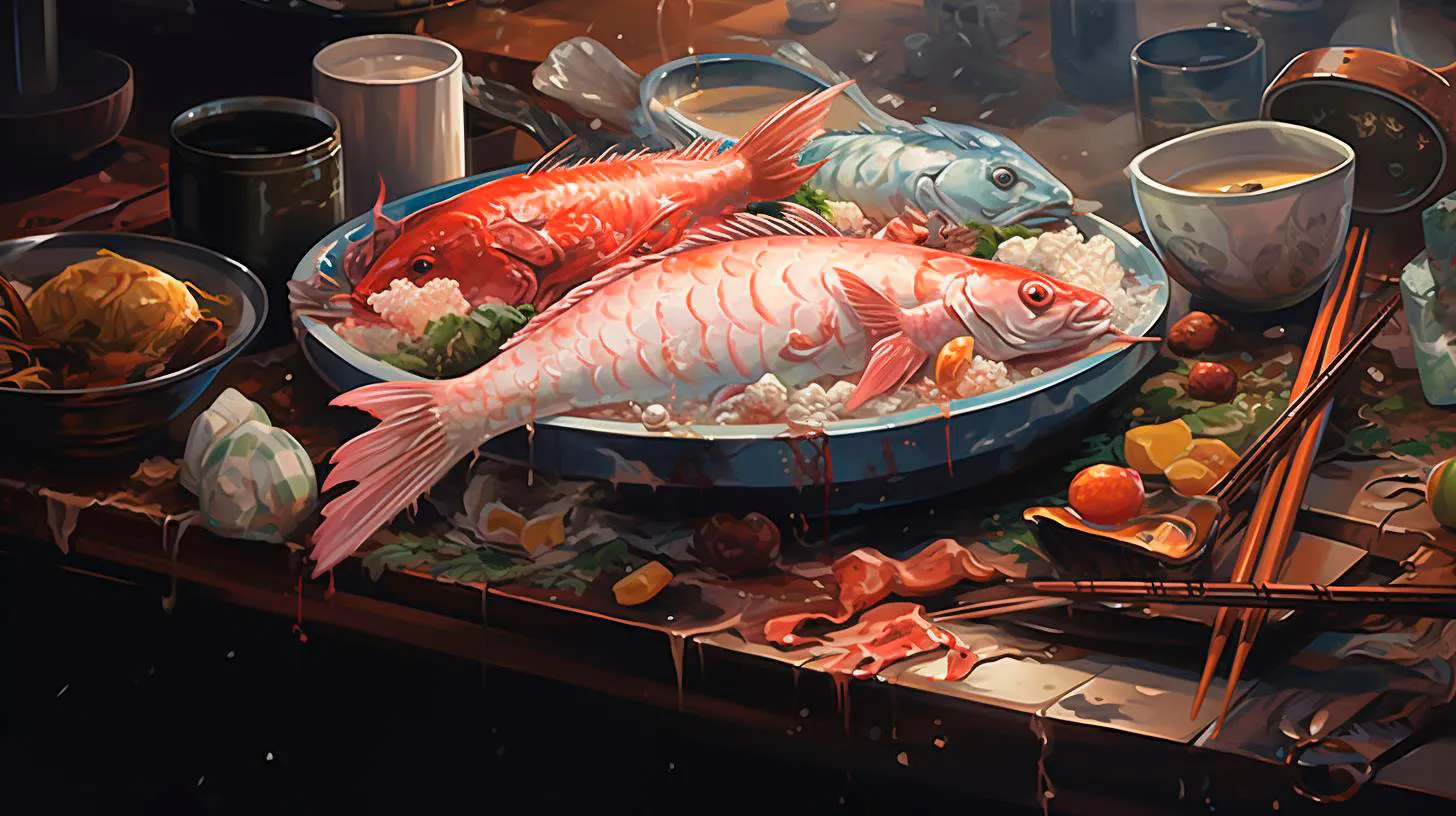The History of Michelin-Starred Sushi
This article delves into the history of Michelin-starred sushi and explores its significance in the culinary world.
The Origins of Sushi
Sushi, in its earliest form, originated in Southeast Asia as a means of preserving fish by fermenting it with rice and salt. This preserved fish was consumed later after the rice was discarded. The technique of fermenting fish with rice made its way to Japan around the 8th century and evolved into what is known as “narezushi.” The rice was now eaten along with the fish, and the dish became a staple in Japanese cuisine.
Over time, narezushi transformed into the more recognizable forms of sushi that we know today. One such development was the invention of “hayazushi” during the Muromachi period (1336-1573). It involved wrapping rice and fish together, allowing for immediate consumption. This was a significant advancement, as it eliminated the need for fermentation and made sushi a more convenient and accessible dish.
The Rise of Sushi Restaurants
In the early 19th century, Edo (now Tokyo) experienced a boom in population. As a result, street food culture flourished, and sushi became increasingly popular. Yatai, or food stalls, started offering sushi as a quick and affordable snack. It was during this time that Hanaya Yohei, a sushi chef, revolutionized the way sushi was served by inventing nigiri sushi – the iconic hand-pressed sushi with a small mound of rice topped with fish or other ingredients. This new style of sushi gained popularity and set the stage for the establishment of sushi restaurants.
As sushi restaurants emerged, chefs began to refine their skills and techniques, focusing on the quality and freshness of ingredients. The art of sushi making became highly specialized, requiring years of apprenticeship and dedication to master. Traditional sushi restaurants started attracting discerning customers who appreciated the precision and attention to detail that went into creating each sushi masterpiece.
The Michelin Guide and Sushi
The Michelin Guide, launched in 1900, aimed to assist motorists with information about hotels, restaurants, and various other travel services. Over time, it gained prestige for its anonymous inspections and the highly sought-after Michelin stars that signify exceptional culinary quality. Initially focusing on European cities, the guide expanded to cover other regions, including Asia.
In 2007, the Michelin Guide came to Tokyo, Japan, and awarded its first-ever three-star rating to Sukiyabashi Jiro, a humble sushi restaurant in Tokyo’s Ginza district. This extraordinary achievement brought international attention to the art of sushi making. Sukiyabashi Jiro, helmed by the legendary sushi master Jiro Ono, became synonymous with the pursuit of perfection in sushi craftsmanship.
Maintaining Michelin-Star Status
Earning and maintaining Michelin-star status is a testament to the dedication and skill of sushi chefs. These culinary artists focus on the highest quality ingredients, meticulous preparation, exquisite presentation, and an exceptional dining experience. Here are key factors that contribute to maintaining Michelin-star status:
- Freshness: Sushi chefs prioritize sourcing the freshest fish and ingredients to ensure optimal taste and quality.
- Craftsmanship: The art of sushi-making requires precision and technique. Chefs undergo extensive training to master their skills over years of practice.
- Presentation: Sushi is not only about taste but also about visual appeal. Presentation plays a crucial role in creating an unforgettable dining experience.
- Innovation: While tradition is paramount, Michelin-starred sushi chefs also showcase their creativity by experimenting with flavors, textures, and ingredients.
Key Takeaways
Merging centuries of tradition with refined craftsmanship, Michelin-starred sushi upholds an extraordinary standard of excellence in the culinary world. Here are the key takeaways:
- Sushi originated as a means of preserving fish, but it evolved into a revered Japanese dish known for its craftsmanship and attention to detail.
- Michelin-starred sushi restaurants showcase the pinnacle of sushi artistry and consistently deliver outstanding dining experiences.
- The Michelin Guide recognizes the skill and dedication of sushi chefs and has helped elevate sushi to new heights.
- Freshness, craftsmanship, presentation, and innovation are critical elements in maintaining Michelin-star status.
As we savor each bite of Michelin-starred sushi, we appreciate the historical journey that has brought us this unparalleled culinary delight.
Exploring the Origins of Michelin-Starred Sushi
In this article, we will take a deep dive into the origins of Michelin-starred sushi and discover how it has shaped the sushi industry today.
Origins of Michelin-Starred Sushi
The story begins in Japan, where sushi has long been a part of their culinary culture. Sushi is believed to have originated as a way to preserve fish by fermenting it with rice in ancient times. It wasn’t until the 19th century that sushi started to evolve into the bite-sized delicacy we know today.
Fast forward to the 20th century, and the sushi scene was rapidly expanding in Japan. Chefs were constantly pushing boundaries, experimenting with new ingredients, and refining their techniques. However, it wasn’t until 2007 that sushi entered the prestigious Michelin guide.
Motivation Behind the Michelin Stars
The Michelin guide, which rates restaurants with up to three stars, was originally created as a marketing tool for tire manufacturer Michelin. The guide aimed to encourage car owners to explore new places and, in turn, use their cars more often, leading to more tire sales. However, the Michelin stars quickly became a symbol of excellence, and chefs worldwide started striving to earn this prestigious recognition.
When it comes to sushi, the Michelin stars proved to be a game-changer. The Guide recognized the dedication, expertise, and creativity it took to master the art of sushi. Michelin-starred sushi restaurants became highly sought after by food enthusiasts, attracting both locals and tourists alike.
Key Features of Michelin-Starred Sushi
What sets Michelin-starred sushi apart from the rest? Let’s explore some key features:
- Premium Ingredients: Michelin-starred sushi relies on the use of high-quality, fresh ingredients. From the finest cuts of fish to seasonal vegetables, only the best is served.
- Masterful Technique: Michelin-starred sushi chefs have spent years honing their craft. Their precise knife skills, perfect rice preparation, and attention to detail make each piece a work of art.
- Balance and Harmony: Every element of the sushi roll or nigiri is carefully balanced to create a harmonious flavor profile. The taste, texture, and presentation come together seamlessly.
- Omotenashi: The concept of omotenashi, or Japanese hospitality, is paramount in Michelin-starred sushi restaurants. Attentive service, personalized recommendations, and a welcoming atmosphere complete the dining experience.
The pursuit of perfection is what drives these renowned sushi restaurants to deliver an unforgettable culinary experience.
The Impact and Benefits
The inclusion of sushi in the Michelin guide has had a profound impact on the industry, particularly for sushi chefs and enthusiasts.
Recognition and Prestige
Receiving a Michelin star is a great honor for any sushi chef. It elevates their status in the culinary world and sets them apart from their peers. Michelin-starred sushi restaurants often see an influx of customers, leading to increased global recognition.
Promotion of Japanese Culinary Arts
The inclusion of sushi in the Michelin guide has helped promote Japanese cuisine and culinary traditions worldwide. It has showcased the artistry and craftsmanship behind sushi-making, encouraging people to explore the rich culinary heritage of Japan.
Higher Standards and Continuous Improvement
Maintaining a Michelin star requires a constant dedication to excellence. This has led to an increase in standards across the sushi industry as chefs strive to reach this level of recognition. The pursuit of a Michelin star pushes chefs to continuously improve their skills and innovate within their craft.
Key Takeaways
- Michelin-starred sushi originated in Japan and has been recognized by the prestigious Michelin guide since 2007.
- Maintaining a Michelin star requires the use of premium ingredients, masterful technique, balance and harmony in flavors, and a commitment to excellent service.
- Michelin stars bring recognition, prestige, and increased customers to sushi restaurants.
- The inclusion of sushi in the Michelin guide has helped promote Japanese culinary traditions globally.
- The pursuit of a Michelin star has raised the standards and quality of sushi across the industry.
Michelin-starred sushi represents the pinnacle of sushi craftsmanship, where tradition meets innovation and excellence reigns supreme. So, the next time you savor a piece of sushi from a Michelin-starred restaurant, remember the rich history and dedication that went into creating that bite-sized masterpiece.
Uncovering the Intriguing Tale of Michelin-Starred Sushi
It’s no wonder that sushi restaurants around the world strive for the prestigious Michelin star, a highly recognized symbol of culinary excellence.
The Journey to Michelin Stardom
Obtaining a Michelin star in the sushi realm is no easy feat. It takes years of training, dedication, and an unwavering commitment to quality. Sushi chefs undergo extensive apprenticeships, honing their skills under the tutelage of masters. This meticulous training equips them with the ability to transform the raw ingredients into a remarkable dining experience.
But what really sets Michelin-starred sushi apart from the rest? Let’s dive deeper into the intricacies of this captivating culinary tale.
The Art of Omakase
One of the defining features of Michelin-starred sushi is the omakase dining experience. Omakase, a Japanese term meaning “I’ll leave it to you,” puts the chef in complete control. The chef curates a personalized menu based on the freshest and most seasonal ingredients available. This elevated dining experience allows patrons to trust the chef’s expertise and embark on a culinary adventure like no other.
Advantages of Omakase-style dining:
- Opportunity to taste rare and exotic ingredients
- Customized menu based on personal preferences
- Interactive and immersive dining experience
- Unparalleled attention to detail and presentation
The Pursuit of Perfection
Maintaining the highest standard of quality is paramount for sushi chefs aspiring to receive a Michelin star. Every element of the sushi, from the fish to the rice, is meticulously chosen and prepared. Freshness is non-negotiable, as top-tier sushi restaurants often have direct relationships with local fishermen to ensure the finest catch.
Key takeaways for achieving perfection:
- Selection of the highest quality seafood
- Understanding the balance of flavors
- Paying meticulous attention to knife skills
- Mastering the art of rice preparation
The Role of Tradition and Innovation
Sushi’s rich history and traditional techniques form the foundation for Michelin-starred establishments. However, innovation and creativity also play a crucial role in standing out. Chefs are always on a quest to elevate the dining experience by incorporating unique flavors, textures, and presentations.
Incorporating tradition and innovation:
- Exploring new ingredients while preserving authenticity
- Introducing novel techniques and flavor combinations
- Embracing artistic presentations that delight the senses
- Constantly pushing culinary boundaries
Michelin Stars as the Ultimate Recognition
The Michelin star system, introduced in 1926, has since become the universally recognized symbol of culinary excellence. Restaurants awarded with Michelin stars are placed into three categories: one star for excellent cuisine, two stars for exceptional cooking worth a detour, and three stars for exceptional cuisine worth a special journey. Obtaining even a single Michelin star is a testament to the chef’s skill, passion, and dedication to creating an unforgettable dining experience.
Takeaways from the Michelin star system:
- Award-winning restaurants offer unparalleled gastronomic experiences
- Michelin stars enhance a restaurant’s reputation and prestige
- Recognition from industry experts attracts discerning diners
- Opportunity for chefs to showcase their creativity and craftsmanship
In Conclusion
Uncovering the intriguing tale of Michelin-starred sushi reveals a world where tradition, innovation, dedication, and passion intertwine to create truly exceptional dining experiences. From the meticulous training of sushi chefs to the pursuit of perfection in taste and presentation, these esteemed restaurants continue to capture the imagination of food enthusiasts worldwide. So, the next time you savor a delectable piece of sushi, remember the fascinating journey it embarked on to earn its Michelin star.
Diving into the Tradition of Michelin-Starred Sushi
A Brief History of Michelin-Starred Sushi
Sushi, a traditional Japanese dish, has been popularized worldwide over the years. Michelin stars, on the other hand, symbolize exceptional culinary standards. Combining these two concepts brings us to the birth of Michelin-starred sushi restaurants.
In 2007, the Michelin Guide, famous for rating restaurants worldwide, expanded its reach to Japan, recognizing the country’s rich culinary heritage. One of the unique aspects of Michelin stars is their consistency across the globe. The three-star rating signifies exceptional quality, two stars indicate excellent cuisine worth a detour, and one star represents a restaurant with high-quality dishes.
Michelin-starred sushi restaurants, such as Sukiyabashi Jiro in Tokyo or Sushi Saito in Tokyo, have gained international recognition. These establishments offer an unforgettable sushi experience, with master chefs devoting their lives to perfecting their craft and preserving traditional sushi-making techniques.
Traditional Techniques and Ingredients
Making sushi is an art form that requires precision, skill, and attention to detail. Michelin-starred sushi chefs dedicate themselves to mastering these traditional techniques handed down through generations.
One prominent technique is “nigiri,” where a piece of raw fish is carefully placed on a small mound of vinegared rice. This technique allows the flavors of the fish to fuse with the delicately seasoned rice. It’s all about finding the right balance of freshness, texture, and taste.
An essential aspect of sushi preparation is sourcing the finest ingredients. The sushi masters focus on using fresh, high-quality fish and seafood to bring out the best flavors. They pay meticulous attention to detail when selecting the ingredients, ensuring they are sustainable, ethically sourced, and adhere to the highest-quality standards.
What Sets Michelin-Starred Sushi Apart
Michelin-starred sushi stands out for several reasons:
- Uncompromising quality: Every aspect of the sushi experience is meticulously curated, from the ingredients to the presentation.
- Attention to detail: Every piece of sushi is carefully handcrafted, with the chef taking utmost care and precision.
- Unique dining experience: Sitting at the sushi counter, guests can witness the skill, precision, and dedication of the sushi master.
- Fusion of tradition and innovation: While preserving traditional techniques, Michelin-starred sushi restaurants also embrace innovation in presentation and flavor combinations.
- Exclusivity: Due to their outstanding reputation, Michelin-starred sushi restaurants often have limited seating, creating an intimate and exclusive dining atmosphere.
Key Takeaways
Exploring the world of Michelin-starred sushi provides a window into the rich traditions and techniques of sushi-making. Here are some key takeaways:
- Michelin-starred sushi restaurants combine the prestige of Michelin stars with the culinary artistry of sushi-making.
- These establishments emphasize traditional techniques, sourcing the finest ingredients, and offering an unforgettable dining experience.
- Meticulous attention to detail distinguishes Michelin-starred sushi, along with a fusion of tradition and innovation.
- Michelin-starred sushi represents the pinnacle of sushi craftsmanship.
If you’re a sushi enthusiast looking for an extraordinary culinary adventure, visiting a Michelin-starred sushi restaurant should be on your bucket list. Prepare to be amazed by the dedication, skill, and unforgettable flavors that these esteemed establishments bring to the table.



